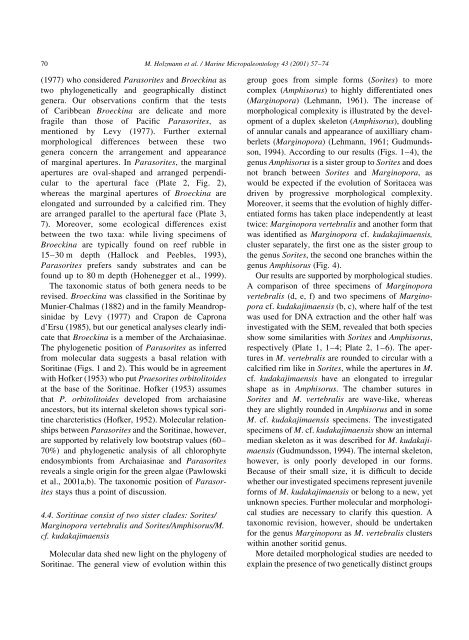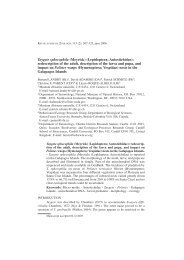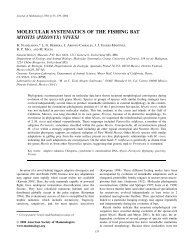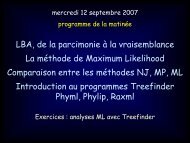Molecular phylogeny of large miliolid foraminifera - University of ...
Molecular phylogeny of large miliolid foraminifera - University of ...
Molecular phylogeny of large miliolid foraminifera - University of ...
Create successful ePaper yourself
Turn your PDF publications into a flip-book with our unique Google optimized e-Paper software.
70M. Holzmann et al. / Marine Micropaleontology 43 2001) 57±741977) who considered Parasorites and Broeckina astwo phylogenetically and geographically distinctgenera. Our observations con®rm that the tests<strong>of</strong> Caribbean Broeckina are delicate and morefragile than those <strong>of</strong> Paci®c Parasorites, asmentioned by Levy 1977). Further externalmorphological differences between these twogenera concern the arrangement and appearance<strong>of</strong> marginal apertures. In Parasorites, themarginalapertures are oval-shaped and arranged perpendicularto the apertural face Plate 2, Fig. 2),whereas the marginal apertures <strong>of</strong> Broeckina areelongated and surrounded by a calci®ed rim. Theyare arranged parallel to the apertural face Plate 3,7). Moreover, some ecological differences existbetween the two taxa: while living specimens <strong>of</strong>Broeckina are typically found on reef rubble in15±30 m depth Hallock and Peebles, 1993),Parasorites prefers sandy substrates and can befound up to 80 m depth Hohenegger et al., 1999).The taxonomic status <strong>of</strong> both genera needs to berevised. Broeckina was classi®ed in the Soritinae byMunier-Chalmas 1882) and in the family Meandropsinidaeby Levy 1977) and Crapon de Capronad'Ersu 1985), but our genetical analyses clearly indicatethat Broeckina is a member <strong>of</strong> the Archaiasinae.The phylogenetic position <strong>of</strong> Parasorites as inferredfrom molecular data suggests a basal relation withSoritinae Figs. 1 and 2). This would be in agreementwith H<strong>of</strong>ker 1953) who put Praesorites orbitolitoidesat the base <strong>of</strong> the Soritinae. H<strong>of</strong>ker 1953) assumesthat P. orbitolitoides developed from archaiasineancestors, but its internal skeleton shows typical soritinecharcteristics H<strong>of</strong>ker, 1952). <strong>Molecular</strong> relationshipsbetween Parasorites and the Soritinae, however,are supported by relatively low bootstrap values 60±70%) and phylogenetic analysis <strong>of</strong> all chlorophyteendosymbionts from Archaiasinae and Parasoritesreveals a single origin for the green algae Pawlowskiet al., 2001a,b). The taxonomic position <strong>of</strong> Parasoritesstays thus a point <strong>of</strong> discussion.4.4. Soritinae consist <strong>of</strong> two sister clades: Sorites/Marginopora vertebralis and Sorites/Amphisorus/M.cf. kudakajimaensis<strong>Molecular</strong> data shed new light on the <strong>phylogeny</strong> <strong>of</strong>Soritinae. The general view <strong>of</strong> evolution within thisgroup goes from simple forms Sorites) to morecomplex Amphisorus) to highly differentiated onesMarginopora) Lehmann, 1961). The increase <strong>of</strong>morphological complexity is illustrated by the development<strong>of</strong> a duplex skeleton Amphisorus), doubling<strong>of</strong> annular canals and appearance <strong>of</strong> auxilliary chamberletsMarginopora) Lehmann, 1961; Gudmundsson,1994). According to our results Figs. 1±4), thegenus Amphisorus is a sister group to Sorites and doesnot branch between Sorites and Marginopora, aswould be expected if the evolution <strong>of</strong> Soritacea wasdriven by progressive morphological complexity.Moreover, it seems that the evolution <strong>of</strong> highly differentiatedforms has taken place independently at leasttwice: Marginopora vertebralis and another form thatwas identi®ed as Marginopora cf. kudakajimaensis,cluster separately, the ®rst one as the sister group tothe genus Sorites, the second one branches within thegenus Amphisorus Fig. 4).Our results are supported by morphological studies.A comparison <strong>of</strong> three specimens <strong>of</strong> Marginoporavertebralis d, e, f) and two specimens <strong>of</strong> Marginoporacf. kudakajimaensis b, c), where half <strong>of</strong> the testwas used for DNA extraction and the other half wasinvestigated with the SEM, revealed that both speciesshow some similarities with Sorites and Amphisorus,respectively Plate 1, 1±4; Plate 2, 1±6). The aperturesin M. vertebralis are rounded to circular with acalci®ed rim like in Sorites, while the apertures in M.cf. kudakajimaensis have an elongated to irregularshape as in Amphisorus. The chamber sutures inSorites and M. vertebralis are wave-like, whereasthey are slightly rounded in Amphisorus and in someM. cf. kudakajimaensis specimens. The investigatedspecimens <strong>of</strong> M. cf. kudakajimaensis show an internalmedian skeleton as it was described for M. kudakajimaensisGudmundsson, 1994). The internal skeleton,however, is only poorly developed in our forms.Because <strong>of</strong> their small size, it is dif®cult to decidewhether our investigated specimens represent juvenileforms <strong>of</strong> M. kudakajimaensis or belong to a new, yetunknown species. Further molecular and morphologicalstudies are necessary to clarify this question. Ataxonomic revision, however, should be undertakenfor the genus Marginopora as M. vertebralis clusterswithin another soritid genus.More detailed morphological studies are needed toexplain the presence <strong>of</strong> two genetically distinct groups






